‘Mega-rare’ bird spotted at Oregon’s Hug Point is first sighting in U.S. history
In a win for animals, cruel raccoon bounty bill fails in Iowa
Wild horses will stay at Theodore Roosevelt National Park after officials back away from removal push
Park officials have scrapped an environmental assessment process that could have resulted in the removal of wild horses that have roamed the park’s south unit since before the park was established.

April 25, 2024 at 1:36 PM
Share
News reporting
This article is free to access.
We’ve opened this article to everyone as a public service. Please consider supporting our work. View subscription offers
MEDORA — The fate of the wild horses at Theodore Roosevelt National Park, which have been at risk of removal, has been resolved after more than two years of uncertainty: The horses will stay.
Sen. John Hoeven, R-N.D., announced Thursday, April 25, that he has “secured a commitment” from the National Park Service to maintain the wild horses in the park.
The park service will “immediately terminate its proposed removal of horses” at the park under an environmental assessment process started in 2022, according to Hoeven.

As a result, Hoeven said, the existing management plan for the horses will remain in place.
“It is a big deal that they’ve now committed to having horses in the park, permanently,” Hoeven told The Forum.
The commitment to keep the horses came from officials including Herbert Frost, the park service’s regional director, and Angela Richman, the park superintendent, Hoeven said.
“This will allow for a healthy herd of wild horses to be maintained at the park, managed in a way to support the genetic diversity among the herd and preserve the park’s natural resources,” according to a statement from Hoeven’s office.
Join the conversation
What are your thoughts on the wild horses staying at the park?Share your comments below.
Now that the park service has committed to keeping the horses, there will be a public discussion about how to manage the herd and what constitutes a genetically healthy herd, Hoeven said.
That must be a “very thoughtful, deliberative, inclusive process,” he said. “There’s no time limit on this.”
Public opinion, not only in North Dakota but around the country, has been overwhelmingly in support of keeping the horses in their home in the rugged badlands of the park, the senator said.
“People love not only horses, but wild horses,” Hoeven said, noting the horses are accessible to the public in the park. “Where do they have an opportunity?”
“I’m shocked,” said Chris Kman, founder of Chasing Horses Wild Horse Advocates, a group in Dickinson that has been working to keep the horses. “It’s excellent news. I’m very happy about this. I just hope they keep a genetically viable herd.”
The horses have been managed under a 1978 environmental assessment that horse advocates say isn’t a true management plan.
That study set the goal of maintaining a herd of 35 to 60 wild horses. The size of the herd has routinely far exceeded that number and recently has been estimated at 200 horses, divided among about 15 bands, each led by a dominant stallion.
The number of horses required to maintain a genetically viable herd with healthy diversity varies, but experts have said that number ranges anywhere from 100 to 240. The higher the number of reproductive horses, the greater the degree of genetic diversity.
The number of reproductive horses is in question because some mares have not returned to fertility after years of administering a birth-control drug, researchers found.

The park has been giving the drug by darting mares of reproductive age since experiments started in 2009.
Researchers at Colorado State University, who conducted the study, notified federal officials in 2020 that 19 of 24 mares, or 79%, that were initially given the vaccine in 2009 had not regained fertility following a booster dose given in 2013.
Under the environmental assessment process that has now been scrapped, the park’s preference was to remove the horses, either gradually, allowing horses to live out their days in the park, or quickly through helicopter roundup removals.
Another option was to keep the horses under current management policy.
Hoeven has been a leading advocate for maintaining the horses in the park at numbers that would ensure the herd’s genetic viability.
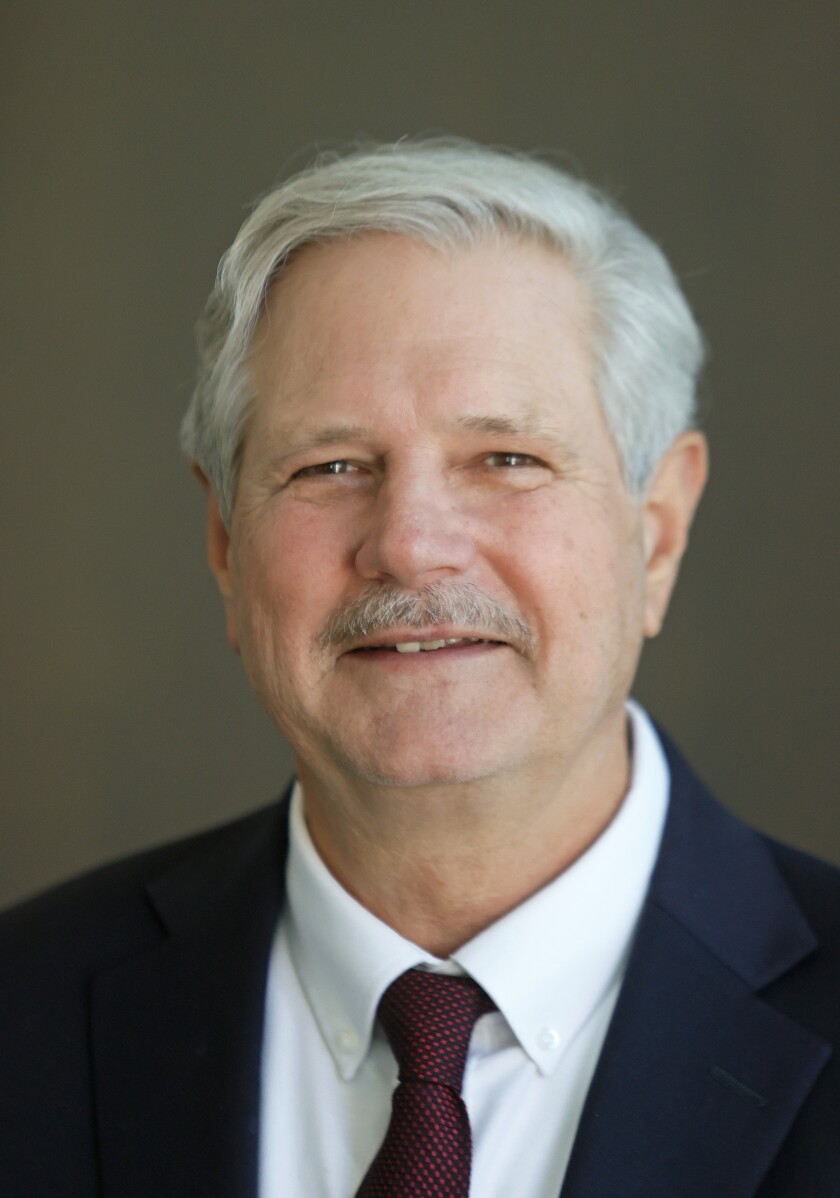
As a member of the Senate Appropriations Committee, Hoeven inserted a provision in annual funding legislation directing the park service to maintain “the historic scene commensurate with the historic herds during the period when President Theodore Roosevelt was a rancher in the area.” Roosevelt raised cattle and hunted in the Little Missouri Badlands near Medora during the open-range ranching era in the 1880s, an experience that inspired him to be what many regard as the greatest conservation president.
“These wild horses are emblematic of President Theodore Roosevelt’s time in North Dakota, a formative experience that shaped his presidency and lasting legacy,” Hoeven said. “Given the broad public support for maintaining the wild horses at Theodore Roosevelt National Park, as well as the measure we passed through Congress, this is the right call by NPS.”
WANT TO READ MORE? SUBSCRIBE FOR THESE AND OTHER EXCLUSIVE STORIES

McFeely: Noem executes a puppy and brags about it, which is exactly the point


McFeely: Charisma was the big loser in debate between Armstrong, Miller

Zandbroz Variety, home to whimsy and charm in downtown Fargo for 33 years, will close in June

McFeely’s Tip Sheet: Prime Time treatment means NDSU-Colorado could draw 10M TV viewers

Home movie from 1917 shows Fargo-Moorhead amid patriotic fervor

Entrepreneur hopes to bring THC-infused frozen treats to Moorhead area

Workers at Moorhead Starbucks first in F-M area to unionize

Drawing Room Fargo promises to bring speakeasy vibe to downtown Fargo
Now that the decision has been made to keep the horses, it will be critical to ensure that the herd is genetically healthy, Kman said.
The horses should have a true management plan, one that is shaped with input from the public, she said. The environmental assessment examined only whether the horses should be removed, not how they should be managed and how big the herd should be.
Richman was not immediately available for comment. In a news release, the park confirmed that it has terminated the environmental assessment.
“The park appreciates the comments and public engagement over the last three years. Information gathered will be used to inform future efforts to manage livestock, horse and cattle herds,” the park’s news release said.

Wild and feral horses were inadvertently fenced into the south unit when the park erected a fence before reintroducing bison to the park in the 1950s. Since the park was established in 1947, park officials had been trying to remove the horses until the early 1970s, when the decision was made to keep horses to depict the open range era of Roosevelt’s time in the Badlands.
Documents show that back in the 1990s, then Superintendent Noel Poe, after consulting with an equine geneticist, decided to keep a herd of 140 horses, in spite of the 1978 goal of maintaining a herd of 35 to 60 horses.
“He said there was currently no policy, no document, that they were using,” Kman said, referring to a memo Poe wrote in the 1990s. “Poe said they weren’t managing the horses under anything.”
Now that the decision has been made to keep the horses, Kman and others will push to provide federal protection for the horses, a process she said likely will take years to pass Congress.
Hoeven said he will wait and see to decide whether to push for federal protection of the horses.
As long as park officials live up to their commitment to permanently keep the horses in the park, and to maintain the herd at a size that is a genetically viable, that might not be necessary “as long as they’re doing that and doing that well,” he said.
Even though some details remain to ensure the herd’s long-term protection, “It’s a good day for the horses,” Kman said.
‘Unprecedented’: How bird flu became an animal pandemic
10 hours ago
By India Bourke,Features correspondentShare https://www.bbc.com/future/article/20240425-how-dangerous-is-bird-flu-spread-to-wildlife-and-humans
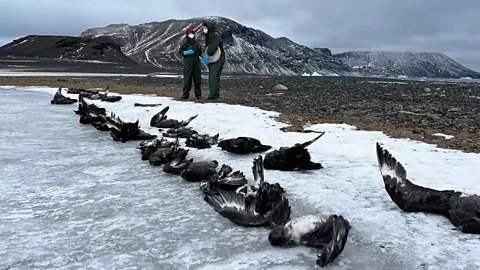 Ben Wallis(Credit: Ben Wallis)
Ben Wallis(Credit: Ben Wallis)
Bird flu is decimating wildlife around the world and is now spreading in cows. In the handful of human cases seen so far it has been extremely deadly.
The tips of Lineke Begeman’s fingers are still numb from a gruelling mission. In March, the veterinary pathologist was part of an international expedition to Antarctica’s Northern Weddell Sea, studying the spread of High Pathogenic Avian Influenza (HPAI), the virus that has now encircled the globe, causing the disease known as bird flu.
Cutting into the frozen bodies of wild birds that the team collected, Begeman was able to help establish whether they had died from the disease. The conditions were harsh and the location remote, far from her usual base at the Erasmus Medical Centre in the Netherlands. But systematic monitoring like this could provide a vital warning for the rest of the world.
“If we don’t study the extent of its spread now, then we can’t let people know what the consequences are of having let it slip through our fingers when it began,” Begeman tells BBC Future Planet. “I imagine the virus as an explorer going through the world, to new places and bird species, and we’re following it along.”
Relatively few people have caught the virus so far, but it has had a high mortality rate in those that do: more than 50% of people known to become infected have died.
 Antonio AlcamíAn expedition to the Antarctic’s Northern Weddell Sea has systematically studied bird flu’s spread in this remote, wildlife-rich region (Credit: Antonio Alcamí)
Antonio AlcamíAn expedition to the Antarctic’s Northern Weddell Sea has systematically studied bird flu’s spread in this remote, wildlife-rich region (Credit: Antonio Alcamí)
Moreover, the impact on animals has already been devastating. Since it was first identified, the H5 strain of avian influenza and its variants have led to the slaughter of over half a billion farmed birds. Wild-bird deaths are estimated in the millions, with around 600,000 in South America since 2023 alone – and both numbers potentially far higher due to the difficulties of monitoring. At least 26 species of mammals have also been infected.
In Antarctica’s Northern Weddell Sea, Begeman and her colleagues sampled around 120 carcasses from different species, including several Antarctic fur seals. The virus was detected at four of the 10 sites they visited.
It was not the first time bird flu had been detected on this remote continent. That first case was a month prior, in February 2024. But theirs was the first confirmation from this particular region, and the first time, Begeman believes, that a multidisciplinary team had set out to systematically determine its Antarctic spread.
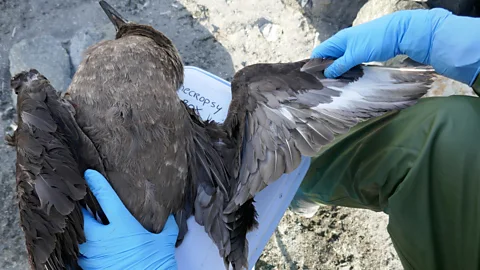 Matteo LervolinoMillions of wild birds are estimated to have died from the spread of high pathogenic avian influenza (Credit: Matteo Lervolino)
Matteo LervolinoMillions of wild birds are estimated to have died from the spread of high pathogenic avian influenza (Credit: Matteo Lervolino)
“The moment we found the first evidence of that destructive serial killer virus amidst such a bird-rich, pristine area, we realised what disaster is about to happen and it became sickening indeed,” says Begeman.
Already the worst bird flu outbreak in wildlife on record, scientists like Begeman are now racing to track its journey – and so better understand how its further spread among humans might be stopped.
Where does bird flu come from?
China’s southern Guangdong region is a mosaic of lakes, rivers and wetlands. These watery habitats are well suited to aquatic birds, who are natural hosts for low pathogenic avian flu. And it was here, in 1996, that a farmed goose became the world’s first bird to be diagnosed with a new, highly pathogenic strain of the virus, known as H5N1.
The categorisation of bird flu as low or high pathogenic was established in relation only to chickens, not to other bird (or mammal) species. But whereas low-path avian influenza is non-fatal in wild birds and only causes mild disease in chickens, in poultry, low path strains can mutate into fatal high-path ones, causing severe illness and often death.
People are the real problem – Thijs Kuiken
It should be no surprise that the highly pathogenic virus’s first case was detected on a poultry farm, says Thijs Kuiken, a comparative pathologist at Erasmus University Medical Centre in the Netherlands. “High pathogenic avian influenza is typically a poultry disease, which doesn’t occur in the wild. What’s unusual now, is this particular type has spilled into wild birds and this has allowed it to spread worldwide.”
Although wild birds have now helped the virus reach far beyond China, “people are the real problem”, Kuiken warns. And in particular, humanity’s ever-rising demand for farmed meat.
When this outbreak started in 1996, there were around 14.7 billion poultry birds in the world, mostly chickens. Now there’s double that number. “Biomass-wise, poultry currently forms over 70% of all avian biomass worldwide,” Kuiken notes.
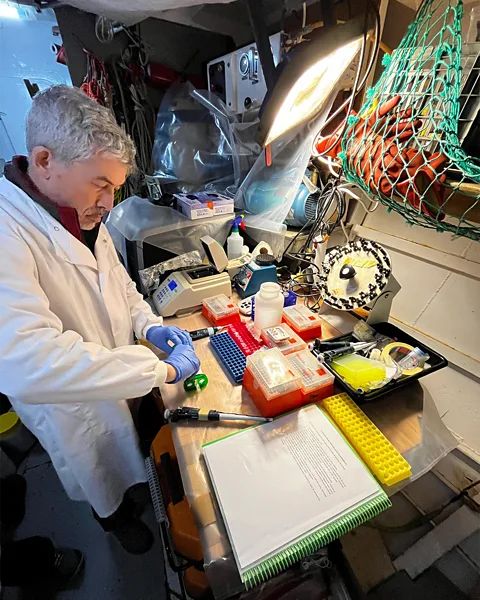 Ben WallisAn on-board laboratory allowed a scientific expedition to Antarctica to test and confirm bird flu’s presence in situ (Credit: Ben Wallis)
Ben WallisAn on-board laboratory allowed a scientific expedition to Antarctica to test and confirm bird flu’s presence in situ (Credit: Ben Wallis)
If the current poultry farming trends don’t change, then “other highly infectious pathogens will continue to spread into the few wild birds remaining,” Kuiken says. House finches, for instance, are proving particularly susceptible to a bacterial poultry disease, Mycoplasma gallisepticum. Virulent strains of Newcastle disease are also crossing over into multiple species, including parrots and macaws. “HPAI [high-pathogenic bird flu] is only one threat.”
How did bird flu spread around the world?
By 2005-06 the virus had spilled over into wild birds and was travelling as far as Europe, Africa and the Middle East, but it was disappearing in these populations after only a few months – likely a combination of not spreading well enough in wild birds, not surviving well enough in water, and some birds developing immunity, says Kuiken. This helped to limit the extent of its impact and its ability to further mutate.
H5N1 timeline
1996: detected in poultry in Guangdong, China
1997: first human deaths in Hong Kong
2005: Spilled over into wild birds in a major way. New strains emerge.
2020: A strain emerges that can sustain in wild bird populations year-round
2020-22: Becomes endemic in wild bird populations
2021: Arrives in North America
2022: Detected in South America
2024: Confirmed in Antarctica
That relative containment changed in 2020, however, when a new strain of H5N1 emerged. Though it’s not known exactly why, the strain could maintain itself in wild bird populations year-round. Now able to spread during springtime when birds gather in high densities to breed, the virus rapidly became endemic in wild bird populations.
In late 2021, the virus arrived in the New World via Canada’s eastern Newfoundland province. A black-backed gull, found sick in a pond, was taken to a wildlife rehabilitation centre where it died the following day. It was later found to be positive for H5N1. Days after its death, a poultry farm started reporting increased mortality rates and autopsies also confirmed presence of the virus.
The fact there was no evidence this farm had imported poultry from Europe helped to confirm scientists’ theories that wild birds’ migration routes are the key long-distance carrier, explains Kuiken. There have been some exceptions, however, such as the transport of infected turkeys from the UK to Europe.
It’s like avoiding getting into a packed metro when you’re already sick – Gregorio Torres
By 2022, birds in colonies from the UK to Israel were dying in their thousands. In October 2022, the virus was detected in wild birds on the west coast of Peru and Chile. After travelling down the coast, it then returned up the east, spreading to the Falkland Islands and South Georgia – the stepping stones to the Antarctic.
Along this route, the virus has diverged to infect a wide variety of mammals – including 21 species in the US alone. And with such cross-over, the opportunity for both human contact and mammal-to-mammal spread has increased.
By 16 April 2024, HPAI was confirmed in dairy cows on 26 farms in the US, from Texas to Michigan. Some of these may have been infected through wild birds, but other cases have been connected to cows’ long-distance transport. So far, only one case of cow-to-human infection is thought to have occurred, and the virus may require several more mutations beforeit can spread easily between people.
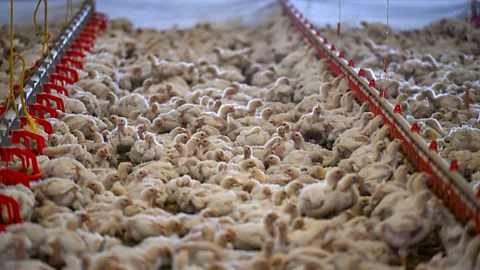 Getty ImagesFarms are being urged to deploy biosecurity measures in the wake of bird flu’s spread (Credit: Getty Images)
Getty ImagesFarms are being urged to deploy biosecurity measures in the wake of bird flu’s spread (Credit: Getty Images)
But farms can create conditions that allow disease to spread more easily, offering new pathways for adaptation. “Wild birds can transmit the virus, but domestic farms can amplify it,” says Gregorio Torres, head of the science department at the intergovernmental body the World Organisation for Animal Health, of the need for farmers to be especially cautious. “It’s like avoiding getting into a packed metro when you’re already sick.”
One bright spot is that birds in New Zealand and Australia have so far been spared. The countries are part of the East Asian-Australian migration route, but their visiting birds are mostly shorebirds or waders, rather than more-susceptible waterfowl like ducks or geese, Kuiken notes.
How does bird flu spread to humans?
The current outbreak of H5N1 bird flu has also hopped species numerous times to infect various mammals, including humans. So far, however, the virus is not thought to have evolved or mutated sufficiently to jump easily between the mammals it infects. The first human cases were reported in Hong Kong in 1997, and the global spread of the virus was relatively slow: during its first 13 years only 800 people were reported infected, with poultry and slaughterhouse workers at greatest risk.
Contact with sick birds – or with their droppings, saliva or feathers – was found to be the biggest risk factor for contracting the virus, though the exact mechanism by which the virus jumps species is not yet known.
Is bird flu the next pandemic?
In March 2024, a new, rare form of the virus was detected in cattle. By April, a farm worker in Texas became the second human in the US to ever contract H5N1 – in what it thought to be the first instance of mammal-to-human transmission.
Cow-to-cow transfer has since been confirmed, with “anything that comes in contact with unpasteurised milk” potentially spreading the disease, according to the US Department of Agriculture.
Every time there’s a jump between species, it’s a signal of potential increased risk – Gregorio Torres
Scientists cannot yet predict if bird flu will become the next global human pandemic, says Torres. Yet what is clear is that the disease is here to stay – and we need to be prepared. “Every time there’s a jump between species, it’s a signal of potential increased risk,” says Torres. “That’s why we’re quickly acting to try to understand and anticipate its evolution.”
Torres adds: “The worst case is it adapts to mammals, with a greater risk of human-to-human transmission.”
Diana Bell, a conservation biologist at the University of East Anglia in the UK, says when people ask her what the next pandemic in humans will be, bird flu immediately comes to mind. “I say we already have a pandemic in animals and birds [a panzootic].”
Can we prevent bird flu in humans?
So can bird flu be stopped? Not in wildlife, experts say; transmission is too hard to prevent. But there are still things we can do to limit the harm to both wild and farmed mammals – as well as humans.
Dead wild birds should be left untouched and reported to authorities, experts encourage. Meanwhile, farms are also being urged to deploy biosecurity measures, from covering waste to reporting illnesses. And the World Organisation for Animal Health (WOAH) is pressing to ensure compensation schemes are in place for all farms that undergo mandatory culling.
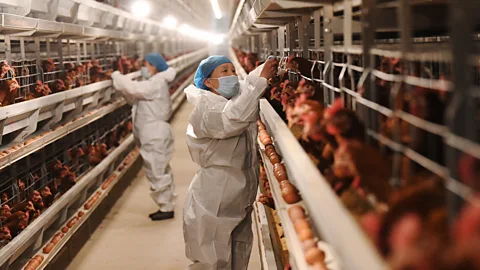 Getty ImagesFarms are being urged to deploy biosecurity measures in the wake of bird flu’s spread (Credit: Getty Images)
Getty ImagesFarms are being urged to deploy biosecurity measures in the wake of bird flu’s spread (Credit: Getty Images)
More controversial is the question of vaccinating poultry. Preventative vaccination in the most high-risk species and areas has been shown to minimise outbreaks, and WOAH advises this. Some nations, like China, already vaccinate routinely, but others have been more reluctant. Not least due to trade barriers which restrict the import of poultry and eggs from vaccinated flocks.
“When you vaccinate poultry, it’s harder to demonstrate absence of disease and early-detect its presence. So it’s posing a challenge for international trade, as everyone wants trade to be safe,” says Torres. But better surveillance can offset this risk, he adds.
Future outbreaks of HPAI could also be controlled and even prevented via reforms to global meat production, Kuiken says. A more sweeping approach could include a cap on the global poultry population size and more equitable consumption – Europe currently eats twice as much meat as global health authorities advise, Kuiken notes. (Read BBC Future’s article on sustainable sources of protein.)
How badly is wildlife affected by bird flu?
HPAI is already a pandemic in global wildlife. “With this virus, the conservation impact is already unprecedented,” says Marcela Uhart, a veterinarian at UC Davis. “It’s on a scale we’ve never seen: in terms of the number of species and regions affected, we’ve never seen anything like it.”
Of particular concern in Uhart’s home nation of Argentina, has been the virus’s spread in wild mammals. Her study into its adaptation to such mammals showed the same virus was nearly identical in fur seals and sea lions, and that many of the adaptations they detected were also present in a human case in Chile. “For all we know it could already be further adapting to spread between mammals – and we need to detect that as quickly as possible.”
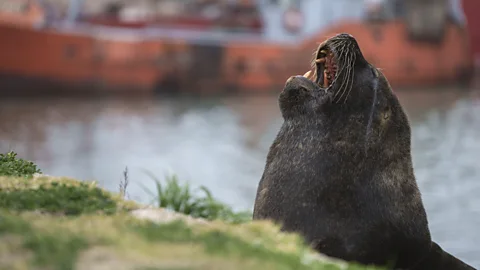 Getty imagesSea lions are among the mammals badly hit by avian influenza (Credit: Getty images)
Getty imagesSea lions are among the mammals badly hit by avian influenza (Credit: Getty images)
And while this is worrying in terms of the future impact on humans, it is also already proving devastating to other mammals: more than 17,000 elephant seals are thought to have died from the virus during the 2023 breeding season, including 70% of all the season’s pups. Since no one knows how many adults went on to die at sea from the virus, Uhart and her colleagues are now waiting apprehensively for the creatures return from the ocean this spring. If enough pregnant females come back, there will be capacity for recovery, Urhart says. If not, or if the virus hits again this year, “the impact could be major”.
“We’re all feeling very anxious about this,” Urhart says. There is pressure to keep monitoring the population-level impact on wildlife, though she says there is inadequate funding. “Everything we’re doing now is on a shoestring,” she says.
But the need to keep monitoring is key. “The removal of these species from the food chain could disrupt the whole ecosystem,” Urhart says. “A lot of what’s coming into the future is just so uncertain.”
How can we help wildlife cope with H5N1?
Reducing other pressures on wildlife could aid their survival as H5N1 becomes a new pressure on bird and mammal species. Climate change, habitat loss, bycatch in fisheries, overfishing, invasive species and pollution – via everything from plastics to pesticides – are all reducing global biodiversity. Easing those human pressures could help give populations infected by HPAI more scope to recover, says Richard Phillips, a seabird ecologist at the British Antarctic Survey.
Phillips’ work on albatrosses has shown that fishing vessels that use mitigation methods (such as not discarding fish at the same time as trawling, and using bird-scaring lines) can reduce the amount of seabird bycatch. With bird flu already hitting the vulnerable wandering albatross, Phillips fears the species’ outlook is “bleak” unless the threat from fisheries is addressed.
In the meantime, scientists will continue to track HPAI’s spread in wild populations, and find new ways to do so.
 Ben WallisMonitoring bird flu’s spread across wildlife populations is key to understanding this human-derived disaster (Credit: Ben Wallis)
Ben WallisMonitoring bird flu’s spread across wildlife populations is key to understanding this human-derived disaster (Credit: Ben Wallis)
Begeman’s expedition, for the first time, set up an entire testing laboratory on an Antarctic-bound ship. Wildlife biologists would scout sampling areas on foot for dead birds, while others would sample apparently healthy animals, she explains. Her role was to cut into the carcasses to investigate, shoo-ing away curious sheathbills as they went. “We were really like detectives, able to get to sites where people had never visited.”
The hope is that by collecting this information from the most far-flung places on the planet, scientists can inform the choices we make closer to home. For Kuiken, policy changes to reduce risk in the poultry industry are high on his list. Meanwhile, vaccination, preventative measures and conservation could all be crucial to help birds and mammals through this outbreak.
What to know about avian influenza in dairy cows and the risk to humans
Scientists confirm Saturn’s moon is habitable in massive breakthrough
Researchers have published new findings claiming that the moon features the six core elements needed for life.
https://www.unilad.com/technology/saturn-moon-enceladus-science-report-habitable-822889-20230615

Published 12:13 15 Jun 2023 GMT+1
A new study has revealed that Saturn’s moon could support life, due to crucial materials found to be residing within its ‘ice-covered water ocean’.
On Wednesday (14 June), a study was published in the scientific journal Nature, titled Detection of phosphates originating from Enceladus’s Ocean.
The subject of the study was Enceladus — a moon off of Saturn which roughly measures 300 miles across and is made of ice — which is often cited as our best chance of finding extraterrestrial life in our solar system.
NASA says Saturn’s rings are ‘acting strange’
Credit: NASA
https://imasdk.googleapis.com/js/core/bridge3.637.1_en.html#goog_1306679102
0 seconds of 2 minutes, 38 secondsVolume 90%
In the report, a research team led by Frank Postberg, the Head of Planetary Sciences and Remote Sensing Professorship Planetary Sciences at Freie Universitat Berlin, said they’d found high levels of phosphorus salts residing on the moon.
Known also as sodium phosphates, scientists have revealed that these concentrations are ‘100-fold higher’ in Enceladus’ ‘plume-forming ocean waters’ than in ‘Earth’s oceans’.
The recent phosphate discovery confirms that all six essential elements of life are present on Saturn’s sixth-largest moon, thus potentially making it habitable.

NASA/JPL/Space Science Institute
The elements in question are carbon, hydrogen, nitrogen, oxygen, sulphur, and phosphorus.
Speaking to Motherboard, Professor Postberg said environments that feature the six key essentials can support life, despite being far away from the sun.
He said: “Enceladus was already considered a pretty habitable place before this.
“The conditions in the ocean seem to be good for life. There are very likely hydrothermal vent systems at the bottom of the ocean that would be an energy source, so you don’t need sunlight.”

Space Telescope Science Institute
He continued to say that on Enceladus, there is also a variety of ‘organic compounds’ that a previously-conducted study had already detected.
The study concludes that Enceladus has satisfied ‘what is generally considered to be the strictest requirement of habitability’.
The findings also suggest that the moon’s ocean ‘could be a harbinger of high phosphorus availability in subsurface oceans across most of the outer Solar System’.
Following the publication of his team’s findings, Professor Postberg said we could investigate Enceladus with the technology currently available to us.
Tornado spotted on sun
Credit: NASA
https://imasdk.googleapis.com/js/core/bridge3.637.1_en.html#goog_1306679103
0 seconds of 20 secondsVolume 90%
“This was basically the last piece that was needed to finally, now, deem Enceladus’ ocean to be habitable without any doubt,” he said.
“Of course, habitable does not mean inhabited. This phosphorus is not something that comes from any life form.
“It’s not produced by life. It’s just an ingredient that, at least for Earth, was essential for the emergence of life.”
He then went on to state: “We could build a spacecraft with today’s technology and send it to Enceladus to answer the question: is this habitable place actually inhabited or not?
“So with the next mission, we will very likely get an answer to that question.”
Trump VP Prospect Kristi Noem Shot And Killed Her Family Dog And Goat, She Reportedly Writes In New Book
Forbes Staff
Sara Dorn is a Forbes news reporter who covers politics.Follow
https://www.forbes.com/sites/saradorn/2024/04/26/trump-vp-prospect-kristi-noem-shot-and-killed-her-family-dog-and-goat-she-reportedly-writes-in-new-book/?sh=62e1d3bf2ffa
Apr 26, 2024,11:07am EDT
TOPLINE
South Dakota Gov. Kristi Noem, floated as a top pick for a potential Trump running mate, wrote in graphic detail about the day she shot and killed her family’s “untrainable” dog and an errant goat in her new book—acknowledging the political imprudence of the bizarre admission, according to The Guardian, which obtained an advance copy of the book.

KEY FACTS
Noem decided to put down the dog, a 14-month-old wirehair pointer named Cricket, after determining it was “untrainable . . . dangerous” and “aggressive,” she reportedly wrote in “No Going Back: The Truth on What’s Wrong with Politics and How We Move America Forward,” set to be published in the U.S. next week.
Noem “realized [she] had to put [Cricket] down” after it misbehaved on a pheasant hunt, then attacked and killed a family friend’s chicken on the way home before attempting to bite Noem when she intervened.
Noem then took Cricket to a gravel pit and shot her, she reportedly wrote.
Cricket was “the picture of pure joy,” but “dangerous to anyone she came in contact with . . . untrainable” and “less than worthless . . . as a hunting dog,” Noem wrote, adding that she “hated that dog.”
After killing Cricket, Noem “realized another unpleasant job needed to be done” and she turned her gun on one of the family’s goats, who she said was “nasty and mean,” smelled “disgusting, musky, rancid” and “loved to chase” her children.
Noem reportedly wrote that she included the graphic story in her book as an example of the “difficult, messy and ugly” jobs she’s willing to do—but acknowledges “I guess if I were a better politician I wouldn’t tell the story here.”

00:22
03:12
Read More
https://imasdk.googleapis.com/js/core/bridge3.637.1_en.html#goog_1022860369
https://imasdk.googleapis.com/js/core/bridge3.637.1_en.html#goog_1022860370
https://imasdk.googleapis.com/js/core/bridge3.637.1_en.html#goog_1022860371
KEY BACKGROUND
Noem was raised in northeastern South Dakota, where she worked on her parents’ farm and cattle ranch prior to her entrance into politics. In her second term as governor, Noem served in the South Dakota state legislature before she was elected to Congress in 2010. Noem has been floated by pundits and media as a potential pick for Trump’s running mate, and he acknowledged to Fox News in February she was one of at least half a dozen contenders on his short list. The two appeared alongside each other at the Ohio rally in March for GOP Senate nominee Bernie Moreno, where Trump told the crowd Noem is “doing an incredible job in South Dakota.”
TANGENT
In another questionable move, Noem shot a testimonial for a Texas cosmetic dental clinic, Smile Texas, that recently gave her veneers. “They wanted to make sure that I was happy with my smile. Not only that the the bite was correct and that I liked the shape, the color, but that it was going to work for me for the rest of my life, and that it was something I could be proud of,” Noem explained in the five-minute video posted last month to her account on X, formerly known as Twitter. Noem has refused to say whether she paid for the dental work. The makeover has raised questions that she’s prepping for prime-time and changing her look in accordance with Trump’s preference for hires that look like they come from what he calls “central casting.” “The whole teeth thing almost looks like it was done for Trump to see. She is showing him she works well in front of the camera, that she has that star power he wants onstage with him, while fitting into the mode of women in the Trump universe,” Republican strategist Ron Bonjean told the New York Times. Trump himself has made allusions to Noem’s appearance, calling her “hot as a politician” during a rally in Ohio last month and telling the crowd “you know you’re not allowed to say she’s beautiful, so I’m not going to say that.”
1 in 5 US retail milk samples test positive for H5N1 avian flu fragments
April 25, 2024

Sakkawokkie/iStock
SHARE
A senior official from the US Food and Drug Administration (FDA) said today that its nationwide survey of retail milk has found remnants of H5N1 avian flu viruses in one in five samples, with the highest concentrations in regions where outbreaks in dairy cattle have been reported.
Donald Prater, DVM, acting director of the FDA Center for Food Safety and Applied Nutrition (CFSAN), shared the new findings with state health officials who took part in a scientific symposium on H5N1 hosted by the Association of State and Territorial Health Officials (ASTHO). The results come in the wake of earlier findings this week from more limited FDA sampling, along with similar findings from a smaller set of samples tested by a lab that’s part of the National Institute of Allergy and Infectious Diseases Centers of Excellence for Influenza Research and Response (CEIRR) Network.
At today’s ASTHO briefing, state health officials heard the latest investigation and research updates from federal health officials and had the opportunity to ask their own questions, everything from virus shedding in cow manure to pandemic preparedness.
FDA’s long list of research questions
Prater reiterated that the FDA hasn’t changed its assessment that the nation’s milk supply remains safe. So far, early work on milk samples that were positive for H5N1 fragments haven’t found any viable (potentially infectious) virus.
He said, however, that the FDA still has a long list of data gaps to fill, including identifying the risk of infection to humans via oral consumption and validating that existing pasteurization methods can inactivate H5N1.
Other data gaps include how long the virus survives in raw milk and the infectious dose of viruses. Though a major concern is retail milk, Prater also said the FDA needs to see if contamination is occurring in other products, such as cheese made from raw milk.
USDA continues to probe farm transmission patterns
Rosemary Sifford, DVM, deputy administrator for veterinary services and chief veterinarian with the US Department of Agriculture (USDA) Animal and Plant Health Inspection Service (APHIS) said the agency has now shared 260 genetic sequences with public databases, up from 239 earlier this week. Of those, only 1 had a mutation linked to mammalian adaptation.
She also said the B3.13 genome circulating in cattle was first seen in poultry in the middle of March in a Texas flock at a time when the virus was cropping up in some of the state’s dairy farms. Sifford said investigators continue to look at how the virus is moving on farms and how it transmits among cattle.
Scientists are looking for the virus in other species, including feral pigs, and regular influenza surveillance is monitoring the situation in commercial pigs. Sifford said efforts are under way to gauge how long infected cows shed the virus and if shedding patterns are any different in asymptomatic animals.
When asked about on-farm transmission, she said scientists haven’t observed significant shedding in cow feces. Meanwhile, sampling from the USDA’s Food Safety and Inspection Service (FSIS) found the highest concentrations in milk and mammary tissue.
CDC notes cat infections, weighs risks
Centers for Disease Control and Prevention (CDC) officials shared more details from their epidemiologic investigations, including virus findings in other animals on affected dairy farms. Sonja Olsen, PhD, associate director for preparedness and response with the CDC’s Influenza Division, said there were 6 H5N1 positive tests in cats from three states: 3 in Texas, 2 in New Mexico, and 1 in Ohio.
Also, there were 5 H5N1 detections in wild birds on the farms.
She said CDC a key question is the infection risk from exposure to milk and whether certain conditions, such as aerosolization, pose a higher risk.
Vivien Duggan, PhD, who heads the CDC’s Influenza Division, said the interagency Flu Risk Management group, which formed 15 years ago, is meeting now to discuss prepandemic vaccines and diagnostics.
On the research front, the CDC is looking for any changes in the virus that would hamper the ability to use countermeasures, such as antiviral drugs and vaccines.
A key tool that the CDC uses to evaluate and prioritize resources is the Influenza Risk Assessment Tool (IRAT), in which its experts grade the virus using 10 data criteria. Duggan said the CDC is still gathering some data and that it will take some time to evaluate the virus and come up with a risk score. In its last assessment in July 2023, the agency scored the H5N1 clade 2.3.4.4b virus from a Spanish mink farm outbreak as slightly higher for some elements than a 2022 virus from the same clade from wild birds.
Latest on vaccines, other countermeasures
So far, research results have been promising for antiviral susceptibility. And for the two candidate vaccine viruses against the H5N1 2.3.4.4b clade, experiments using ferret antisera show good cross-reaction against the outbreak strain, she said.
When state officials asked what would trigger ramped up H5N1 vaccine production, Duggan said officials are watching for certain cues, such as change in mammalian transmission, better adaptation to human-to-human spread, and clusters of cases. “There’s no formula, but we’re all on the watch.”
Health officials also heard from government countermeasure experts, who said they don’t foresee any issues with the antiviral supply chain.
State health officials had several questions about where things stand with a candidate vaccine. David Boucher, PhD, director of infectious disease preparedness and response at the Department of Health and Human Services Administration for Strategic Preparedness, said there is a limited quantity of prefilled syringes and vials that are used for clinical trials, for example. He added that health officials are already looking at regulatory pathways to use the vaccine more widely, if needed.
He said the first wave of production, if needed, could provide several hundreds of thousands of vaccine doses, and the second tranche could amount to 10 million doses. “Any pivot from that would require additional resources,” Boucher said. “If we need to pull any of those levers, we’re willing to do so.”
Partnering with established seasonal flu vaccine producers has the benefit of a licensed platform in place that can be easily adapted to include an H5N1 vaccine virus, but he acknowledged that a downside would be a potential disruption in seasonal flu vaccine production. “There are a lot of variables that go into making that decision.”
Two safety and immunogenicity studies are already under way on candidate H5N1 vaccines, Boucher told the group.
A MORE COMPREHENSIVE PLAN TO PUSH BACK AGAINST CHINA’S FISHING PRACTICES
APRIL 25, 2024
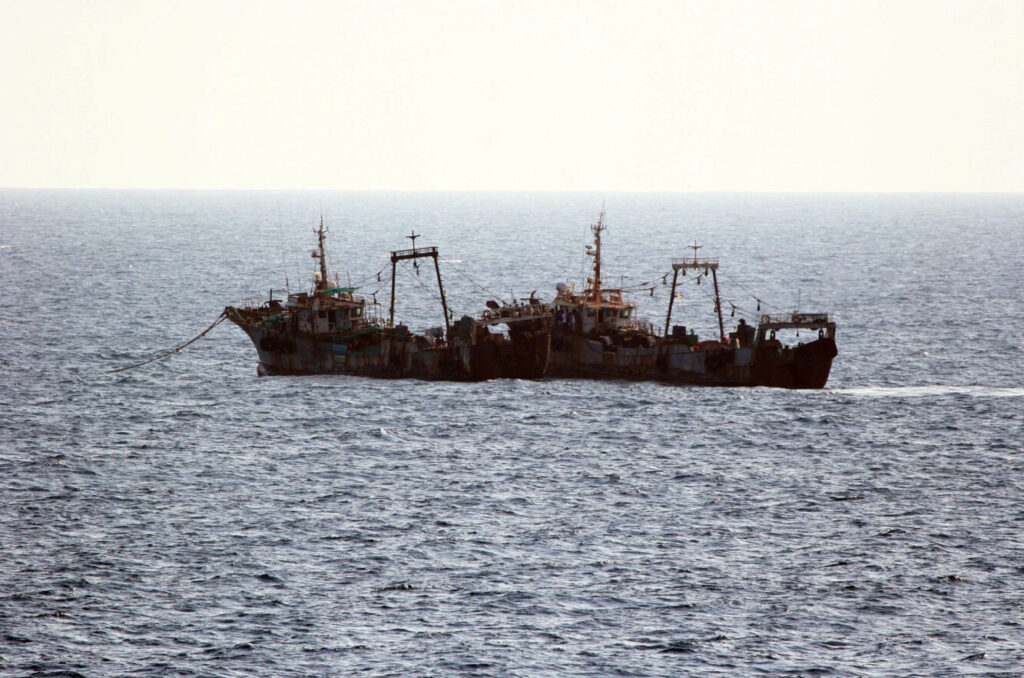
After spending years working and living in Africa, I have learned you cannot take anything for granted. Even though foreign navies and coast guards exist on paper, that does not mean they have boats that float and work. Even if they do have boats that float and work, that does not mean they have fuel or spare parts. Even if the boats are able to regularly operate, that does not mean they put a dent in maritime crime because maritime law enforcement is only one component of a government effectively policing its waters.
In December 2022, U.S. Coast Guard Cmdr. Aaron Delano-Johnson and U.S. Navy Cmdr. Chris Bernotavicius published an article in War on the Rocks where they argued that the U.S. government should more aggressively confront Chinese illegal, unreported, and unregulated fishing practices across the globe. Unlike current U.S. strategies, the authors consider these practices a “coercive tool of Chinese statecraft” and frame them as a component of strategic competition. Delano-Johnson and Bernotavicius propose that the U.S. Coast Guard, due to the service’s unique capabilities and relationships, lead efforts against Chinese fishers by helping partner governments to develop more effective maritime enforcement capabilities that ideally become self-sufficient.
This proposal, however, takes the functioning of other state institutions for granted and fails to address the larger problems that facilitate harmful Chinese fishing practices.
Illegal, unreported, and unregulated fishing in general and Chinese fishing practices in particular do pose significant threats to international and U.S. national security. Meaningfully addressing these threats, however, would require a more robust response than what Delano-Johnson and Bernotavicius propose. A more effective U.S. approach should more directly confront the system of factors that prevent a foreign government from effectively policing its waters. In addition to maritime enforcement, two other significant factors include corruption and economic coercion. All these factors significantly impact many U.S. partner governments’ ability to police their waters, and focusing on maritime enforcement while failing to address corruption and coercion would likely result in a failure to effectively push back against harmful fishing practices even if the U.S. Coast Guard is able to train a perfect foreign counterpart.
A Significant National Security Threat
Illegal, unreported, and unregulated fishing practices, particularly as practiced by the Chinese fishing fleet, pose multiple threats to international and U.S. national security. These practices often lead to overfishing, which depletes local fishing stocks and makes it difficult for the poorest in costal countries to afford the fish they rely on as their primary source of protein. Overfishing depresses local fishing industries, eliminating the livelihoods of many of the same people. These practices also challenge global norms and infringe upon the sovereignty of any country in which they occur.
The Chinese government heavily subsidizes the Chinese distant-water fishing fleet, which is the largest in the world and often engages in illegal, unreported, and unregulated fishing. The Chinese government further aids this fleet by coercing foreign governments to minimize enforcement against Chinese vessels, and it uses many of the same fishing vessels as part of its maritime militia, which operates in waters closer to home.
The 2022 U.S. National Security Strategy mentions the necessity for U.S. support to allies and partners that “stand on the frontlines of the [People’s Republic of China] coercion and are rightly determined to seek to ensure their own autonomy, security, and prosperity.” Governments that suffer from illegal Chinese fishing practices are on the frontlines of daily Chinese government coercion and threats to autonomy, security, and prosperity.
Challenges to Enforcement
There are many challenges that enable illegal, unreported, and unregulated fishing practices beyond poor maritime enforcement. Two main challenges include corruption and susceptibility to economic coercion, and both of these permeate through many of the countries the U.S. government wants to help combat such practices.
A government’s ability to police its exclusive economic zone, 200 nautical miles from its coastline, neither starts nor stops on the water. Before maritime enforcement takes place, governments pass laws, participate in international agreements, and issue permits to regulate how fishing should be conducted. Should a navy or coast guard apprehend illegal fishers, a government’s criminal justice system levies punishments to disincentivize further violations.
Corruption is pervasive throughout the global fishing industry and undermines regulation through bribes to politicians who oversee the process, officials who issue fishing permits, law enforcement personnel, investigators, prosecutors, and judges, among others. Fighting corruption presents a significant challenge to a majority of the partners the U.S. government wants to engage with to combat illegal, unreported, and unregulated fishing. The October 2022 U.S. Interagency Working Group on Illegal, Unreported, and Unregulated Fishing’s National 5-Year Strategy for Combatting Illegal, Unreported, and Unregulated Fishing lists 57 priority countries in Latin America, Africa, Asia, and the Pacific Ocean where U.S. government assistance is most needed. The World Bank assessed 50 of these 57 priority countries in 2021. Thirty of them scored in the bottom 50th percentile for control of corruption, and 17 of those scored in the bottom 25th percentile.
As an example, Ghana is one of the U.S. government’s strongest partners in West Africa, one of the strategy’s priority countries, and scored just above the 50th percentile for control of corruption, making it an above-average country. The Environmental Justice Foundation, a British non-governmental organization, found in an October 2022 study about the Chinese-owned fishing fleet in Ghana that a “culture of corruption” exists throughout the official Ghanaian fishing management system. The majority of the Ghanian fishing sector personnel who the foundation interviewed had witnessed corruption from port authorities, members of the navy, and official government fishing observers.
Furthermore, according to a January 2023 BBC story, most of the Ghanian government fishing observers take bribes due to “fear, corruption, and neglect.” The neglect the article is referring to is that the government is paying these observers meager salaries infrequently, if at all, driving them to seek alternate sources of income to make a living and support their families. In my experience, this form of neglect among government workers is common throughout much of Africa and often leads to corruption out of economic necessity. Ghana’s relatively high scores in controlling corruption make it likely that corruption would pose an even greater challenge when trying to confront illegal, unreported, and unregulated fishing in a majority of the working group’s priority countries.
The Chinese government adds to these difficulties, making its support to illegal, unreported, and unregulated fishing particularly acute. With the second-largest economy in the world, the Chinese government uses its significant power and influence to coerce governments into minimizing enforcement against Chinese fishing vessels. As Delano-Johnson and Bernotavicius point out, one way the Chinese government does this is by forcing governments to choose between prosecuting Chinese fishing vessels or accepting Chinese aid. “It’s hard to say no to China when they are building your roads,” as one former head of Senegal’s Oceanic Research Institute puts it. Senegal is one of five “flag states” that the working group’s strategy designates as a focus of U.S. government-to-government engagement to counter illegal, unreported, and unregulated fishing.
Many of the strategy’s priority countries are also underdeveloped, making them vulnerable to coercion with foreign aid. The United Nations assessed 49 of the strategy’s 57 priority countries in 2021. Twenty-one of them, including Ghana, are in the medium human development category. Eight, including Senegal, are in the low human development category. These are the two lowest human development categories of four.
Challenges to Self-Sufficiency
Pervasive corruption and susceptibility to economic coercion would make it extremely difficult for Delano-Johnson and Bernotavicius’ solution to become self-sufficient. They propose that the U.S. Coast Guard’s maritime security cooperation efforts be modeled after the Department of State’s Global Peace Operations Initiative, but this initiative is also unlikely lead to lead self-sufficiency. Its primary goal is to help partner militaries develop forces that contribute to U.N. peacekeeping operations, and the authors provide examples of notable successes. The successes, however, rely on the United Nations to pay governments directly for their troop contributions.
For maritime enforcement capabilities to reach true self-sufficiency, countries need a reliable internal source of income. Some portion of this income could come from governments issuing fishing licenses and imposing fines on guilty illegal, unreported, and unregulated fishers. The governments, however, must be capable of effectively doing both to collect enough revenue to pay for the operations. Corruption and economic coercion undermine these processes.
An ineffective system to effectively punish illegal, unreported, and unregulated fishers could also create motivation and morale problems within a maritime force, no matter how well-trained, further hindering its performance. To paraphrase what a senior African counterpart once told me, “Why should military members risk their lives on the high seas to catch illegal fishers if they know the fishers will just be let free when they are pulled into port?” In other words, if the navy or coast guard knows nothing will happen to any illegal fishers they catch, then why should they bother patrolling their country’s waters?
Finally, government leaders must want to maintain a capability before the capability can become self-sufficient. One adage of security cooperation is “you can’t want it more than they do.” For any maritime security cooperation to bear long-term dividends and produce capable maritime forces after U.S. trainers leave, host-nation government and military leaders must want to maintain the forces. If government leaders are gaining financially through corruption or politically through economic aid, then they may have little to no motivation to start enforcing fishing regulations and see their income and political support disappear.
A More Holistic Solution
The U.S. Coast Guard is the right organization to lead security cooperation efforts against Chinese illegal, unreported, and unregulated fishing practices. Focusing on security cooperation without addressing the other issues that prevent partner governments from effectively policing their waters may result in short-term success but would likely result in long-term failure. Instead, other agencies, like the Department of State or U.S. Agency for International Development, should lead a more holistic approach to challenge Chinese fishing practices at sea as well as challenge corruption within the fishing industry and propose viable alternatives to Chinese economic coercion.
A more effective U.S. approach would seek to change the incentives for enough partner government officials to want to effectively police a country’s waters and maintain a maritime enforcement capability after U.S. trainers leave. Many of these officials would likely not be in the military, like fishing observers and judges.
The Department of State and U.S. Agency for International Development specialize in conducting holistic approaches to security issues due to their unique capabilities and relationships. They work with foreign governments to decrease corruption and improve criminal justice systems. The U.S. Agency for International Development’s specialty is economic development, which would likely be necessary to provide viable alternatives to Chinese economic coercion. The Biden administration’s “Memorandum on Combatting Illegal, Unreported, and Unregulated Fishing and Associated Labor Abuses,” released four months prior to the working group’s strategy, calls on the U.S. Agency for International Development Administrator to lead anti-corruption and judicial reform efforts as well. The Department of State works regularly with and funds U.S. Coast Guard and military security cooperation efforts, like the Global Peace Operations Initiative, and it has a bureau that specializes in training police and strengthening criminal justice institutions. The Department of State also recently opened the Office of China Coordination to manage U.S. competition with China.
Conclusion
The Chinese government uses subsidies and coercion to enable the Chinese distant-water fishing fleet to conduct illegal, unreported, and unregulated fishing across the globe. These activities represent a direct threat to the rules-based international system, and they occur daily in multiple countries that have a minimal capacity to push back and have structural governance issues that disincentivize them from doing so. These illegal fishing activities also represent a daily threat to the lives and livelihoods of the poorest citizens within these countries.
For the U.S. government to more effectively push back against harmful Chinese fishing practices and help create indigenous, self-sustaining maritime enforcement capabilities, it should not focus its efforts primarily on maritime security cooperation led by the U.S. Coast Guard. Instead, the U.S. government should address the system of factors that enable illegal Chinese fishing practices, including government corruption and Chinese economic coercion as well as maritime enforcement. A more holistic approach would likely have to be led by a more holistic agency that already addresses similar issues, such as the Department of State or U.S. Agency for International Development.
More aggressively pushing back against Chinese illegal fishing practices is an opportunity for the U.S. government to highlight its global leadership in a way that directly defends the rules-based international order, challenges its most capable global competitor, helps rehabilitate the maritime environment, and increases the food security and economic opportunity for some of the world’s poorest and most helpless people. But Chinese fishers are not the only ones that engage in illegal, unreported, and unregulated fishing, and the U.S. government should not take its own institutions and those of its partners and allies for granted. The U.S. government should also ensure it is effectively pushing back against the lesser but not insignificant numbers of American, allied, and partner fishers who conduct the same activities. To truly defend the rules-based order against all violators, the U.S. government should ensure U.S. fishers follow the rules, and it should be willing to defend the rules from its best friends and most fierce competitors alike.
Michael E. Clark is an active-duty U.S. Marine lieutenant colonel, F/A-18 weapons systems officer, and Africa foreign area officer.
The views expressed are those of the author and do not reflect the official position of the Department of Defense, Department of the Navy, or U.S. Marine Corps.

